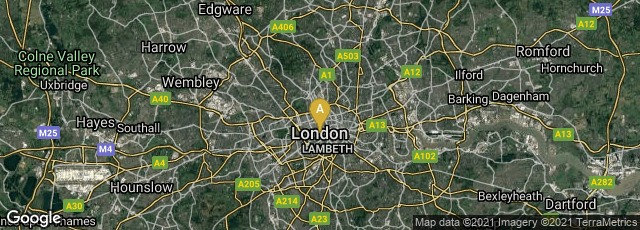

A: London, England, United Kingdom
In the second volume of his autobiography, Passages of a Working Life, Vol. 2, pp. 114-115 we learn that Charles Knight wrote the text of what became a 3-volume work on animals entitled Menageries, Described and Drawn from Living Subjects, and he was determined to have this work illustrated with woodcuts, and issued at a low price under the auspices of the SDUK. This book became the first book printed on a printing machine that included images printed by the new technology. Like most of Charles Knight's publications, this book was printed by William Clowes, a large industrial book printer in London, who was one of the first to apply the new high speed presses in book production. In his autobiography Knight recounted what a monumental step in the history of book production producing an illustrated work by a high speed press was recognized to be at the time, such that virtually the entire committee of the SDUK desired to be present at the printer when the first sheets were printed. As is apparent from the illustration of the upper printed wrappers, the members of the SDUK were listed prominently on the cover of the volumes.
Knight wrote:
"In looking back at some correspondence of September, 1828, I am enabled to form an accurate conception of the technical difficulties of producing a cheap book with excellent wood-cuts. I had arranged to have my 'Menageries' illustrated with representations of animals drawn from the life. I was fortunate in securing the assistance of several rising young men, who did not disdain what some painters might have deemed ignoble employment. Two of these are now Royal Academicians. There were not many wood-engravers then in London; and this art was almost invariably applied to the production of expensive books, printed in the finest style. The legitimate purpose of wood-engraving was not then attained. It is essentially that branch of the art of design which is associated with cheap and rapid printing. In the costly books of period a single woodcut introduced into a sheet to be worked off with the types, enhanced the cost of manual labour in a proportion which would now seem incredible. In engraving the wood-cuts for the 'Menageries,' some attention of the artist was necessary to give his shadows the requisite force, and his lights the desired clearness, so as to meet the uniform application of the ink, and the cylindrical pressure, in the printing-machine process. It was long before this excellence could be practically attained. Without this explanation it would appear ludicrous that Mr. Hill should write to me from Mr. Brougham's house, --'Everybody here is in raptures with the proofs of the wood-cuts; but we have misgivings about the machine.' A sheet of my book was to be set up with the engravings in their due place, and a hundred or two were to be printed off by the rapid operation. 'Mr. Loch is here,' writes Mr. Hill. 'We have held a committee. He will be in London in a fortnight, quite at leisure, and anxious to attend to our affairs. He has promised to assist at Clowes's [the printers]. I hope you will succeeed in assembling everybody.' 'Everybody' not only meant the patentee of the machine, the wood-engraver, the stationer, the ink-maker, and the ingenious overseer of the printing office, but as many of the committee as I could get together. Imagine a learned society thus employed! Imagine a hard-worked editor thus exhorted to interference with a printer's proper duty! Yet such was part of my editorial duty at a time when the great revolution in the production of books to be accomplished by the printing machine, was almost as imperfectly realised as when Caxton first astonished England by the miracles of the printing press. We succeeded in partially overcoming the difficulties of making an illustrated volume not despicable as a work of art, and yet cheap--something very different from the lesson books with blotches called pictures, that puzzled the school-boy mind half a century ago, to distinguish what some daub was meant to delineate...."